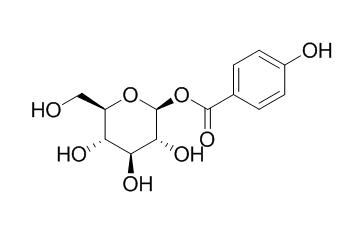1-(4-Hydroxybenzoyl)glucose
1-(4-Hydroxybenzoyl)glucose is a natural product from Luffa cylindrica (L.) Roem.
Inquire / Order:
manager@chemfaces.com
Technical Inquiries:
service@chemfaces.com
Tel:
+86-27-84237783
Fax:
+86-27-84254680
Address:
1 Building, No. 83, CheCheng Rd., Wuhan Economic and Technological Development Zone, Wuhan, Hubei 430056, PRC
Providing storage is as stated on the product vial and the vial is kept tightly sealed, the product can be stored for up to
24 months(2-8C).
Wherever possible, you should prepare and use solutions on the same day. However, if you need to make up stock solutions in advance, we recommend that you store the solution as aliquots in tightly sealed vials at -20C. Generally, these will be useable for up to two weeks. Before use, and prior to opening the vial we recommend that you allow your product to equilibrate to room temperature for at least 1 hour.
Need more advice on solubility, usage and handling? Please email to: service@chemfaces.com
The packaging of the product may have turned upside down during transportation, resulting in the natural compounds adhering to the neck or cap of the vial. take the vial out of its packaging and gently shake to let the compounds fall to the bottom of the vial. for liquid products, centrifuge at 200-500 RPM to gather the liquid at the bottom of the vial. try to avoid loss or contamination during handling.
Acta Physiologiae Plantarum2015, 37:1736
Foods.2021, 10(12):2929.
Antioxidants (Basel).2020, 9(6):544.
BMC Plant Biol.2020, 20(1):214.
Aging (Albany NY).2023, 15(24):15557-15577.
Fitoterapia.2024, 177:106138.
Nutrients.2024, 16(7):985.
Molecules.2023, 28(5):2376.
Front Pharmacol.2022, 13:806869.
Sci. Rep.2015, 14-23
Related and Featured Products
J Agric Food Chem. 2006 Jun 14;54(12):4186-90.
Antioxidant constituents in the fruits of Luffa cylindrica (L.) Roem.[Pubmed:
16756345 ]
METHODS AND RESULTS:
Hydrophilic antioxidant constituents in the fruits of the vegetable Luffa cylindrica (L.) Roem (sponge gourds) were separated by an antioxidant-guided assay to yield eight compounds: p-coumaric acid (1), 1-O-feruloyl-beta-D-glucose (2), 1-O-p-coumaroyl-beta-D-glucose (3), 1-O-caffeoyl-beta-D-glucose (4), 1-O-(4-hydroxybenzoyl)glucose (1-(4-Hydroxybenzoyl)glucose,5), diosmetin-7-O-beta-D-glucuronide methyl ester (6), apigenin-7-O-beta-D-glucuronide methyl ester (7), and luteolin-7-O-beta-D-glucuronide methyl ester (8). The eight compounds were isolated by high-speed countercurrent chromatography and identified by electrospray ionization-mass spectrometry and NMR analysis, and the antioxidant activity was evaluated by the radical scavenging effect on the 1,1-diphenyl-2-picrylhydrazyl radical. High-performance liquid chromatography analysis showed that a total amount of the eight compounds in the dried gourds without skin was about 1%.
CONCLUSIONS:
The results demonstrate that the consumption of sponge gourds can supply some antioxidant constituents to human body.



